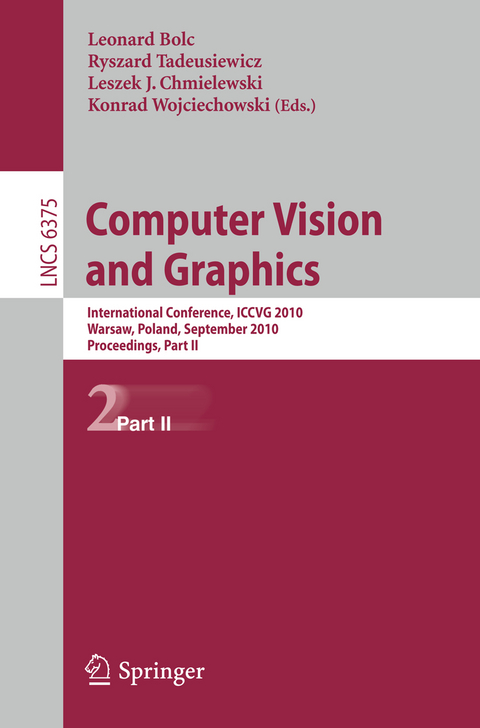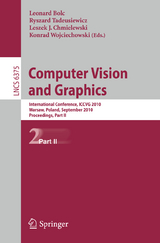Computer Vision and Graphics
Springer Berlin (Verlag)
978-3-642-15906-0 (ISBN)
Computer Vision and Graphics.- A Constraint Satisfaction Framework with Bayesian Inference for Model-Based Object Recognition.- Visual Programming Environment Based on Hypergraph Representations.- MRI Brain Segmentation Using Cellular Automaton Approach.- Improved Context-Based Adaptive Binary Arithmetic Coding in MPEG-4 AVC/H.264 Video Codec.- Local Polynomial Approximation for Unsupervised Segmentation of Endoscopic Images.- A Proper Choice of Vertices for Triangulation Representation of Digital Images.- A Method for Novel Face View Synthesis Using Stereo Vision.- Outer Surface Reconstruction for 3D Fractured Objects.- Application of the FraDIA Vision Framework for Robotic Purposes.- Video Analysis Based on Mutual Information.- Speeding Up Powerful State-of-the-Art Restoration Methods with Modern Graphics Processors.- Multi-layered Framebuffer Condensation: The l-buffer Concept.- Accurate Overlap Area Detection Using a Histogram and Multiple Closest Points.- Automatic Extraction of the Lower Boundary of the Mandibular Bone in Dental Panoramic Radiographs.- Football Player Detection in Video Broadcast.- Spectrum Evaluation on Multispectral Images by Machine Learning Techniques.- Fatigue Detector Using Eyelid Blinking and Mouth Yawning.- Inferior Maxillary Bone Tissue Classification in 3D CT Images.- Vector Median Splatting for Image Based Rendering.- Feature Extraction Using Reconfigurable Hardware.- Automated Counting and Characterization of Dirt Particles in Pulp.- Keypoint-Based Detection of Near-Duplicate Image Fragments Using Image Geometry and Topology.- Three Cameras Method of Light Sources Extraction in Augmented Reality.- The Context-Sensitive Grammar for Vehicle Movement Description.- The Method for Verifying Correctness of the Shape's Changes Calculationin the Melting Block of Ice.- A Real Time Vehicle Detection Algorithm for Vision-Based Sensors.- Sequential Reduction Algorithm for Nearest Neighbor Rule.- GPU-Supported Object Tracking Using Adaptive Appearance Models and Particle Swarm Optimization.- GFT: GPU Fast Triangulation of 3D Points.- Methods for Visualization of Bone Tissue in the Proximity of Implants.- An Evaluation of Image Feature Detectors and Descriptors for Robot Navigation.- The Visual SLAM System for a Hexapod Robot.- Displacement Calculation of Heart Walls in ECG Sequences Using Level Set Segmentation and B-Spline Free Form Deformations.- Fast and Accurate Machined Surface Rendering Using an Octree Model.- PATSI - Photo Annotation through Finding Similar Images with Multivariate Gaussian Models.- Generation of Temporally Consistent Depth Maps Using Nosie Removal from Video.- Smooth Detail Features on Multiresolution Surface.- Using Parallel Graph Transformations in Design Support System.- Fast, Parallel Watershed Algorithm Based on Path Tracing.- Detection of Tumor Tissue Based on the Multispectral Imaging.- A New Method for ECG Signal Feature Extraction.- Error Concealment Method Selection in Texture Images Using Advanced Local Binary Patterns Classifier.- Early Warning System for Air Traffic Control Using Kinetic Delaunay Triangulation.- GPU Calculated Camera Collisions Detection within a Dynamic Environment.- Utilization of Multi-spectral Images in Photodynamic Diagnosis.- The Spectral Analysis of Human Skin Tissue Using Multi-spectral Images.- Can the Coronary Artery Centerline Extraction in Computed Tomography Images Be Improved by Use of a Partial Volume Model?.
| Erscheint lt. Verlag | 13.9.2010 |
|---|---|
| Reihe/Serie | Image Processing, Computer Vision, Pattern Recognition, and Graphics | Lecture Notes in Computer Science |
| Zusatzinfo | XVI, 395 p. 237 illus. |
| Verlagsort | Berlin |
| Sprache | englisch |
| Themenwelt | Informatik ► Grafik / Design ► Digitale Bildverarbeitung |
| Schlagworte | Algorithm analysis and problem complexity • Biomedical Images • Computational Geometry • Computer Art • computer vision • digital watermarking • Face Tracking • geometrical modeling • human visual perception • ICCV • Image Processing • Machine vision • motion analysis • motion detection • MPEG-4 • multispectral images • Object recognition • Rendering • Scene Understanding • Shading • Visualisation • Visualization |
| ISBN-10 | 3-642-15906-0 / 3642159060 |
| ISBN-13 | 978-3-642-15906-0 / 9783642159060 |
| Zustand | Neuware |
| Informationen gemäß Produktsicherheitsverordnung (GPSR) | |
| Haben Sie eine Frage zum Produkt? |
aus dem Bereich




